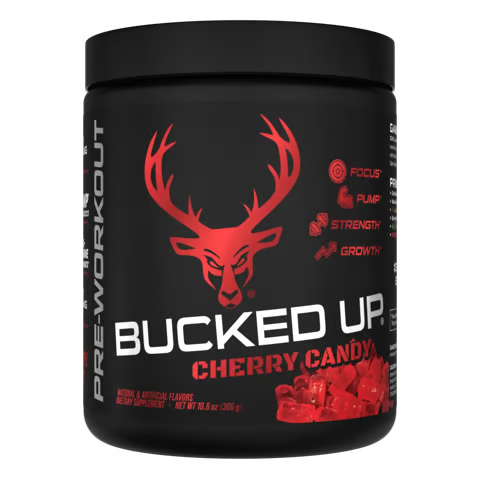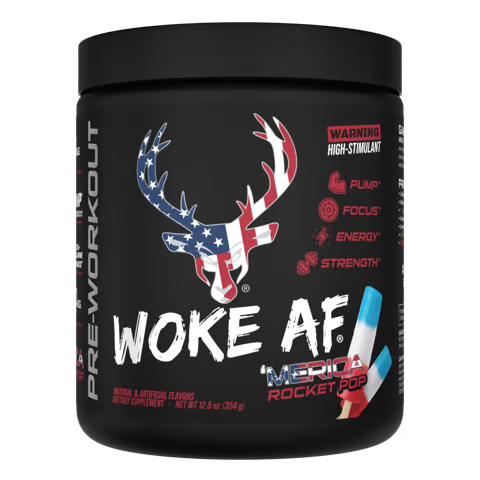A solid warm-up sets the stage for a successful workout. This guide walks you through a step-by-step process to optimize blood flow and nitric oxide production using targeted warm-up techniques. Pair these methods with a well-formulated pre-workout, and you can elevate every lifting session from start to finish. Preparation often determines whether your workout is just okay or truly effective.
Check out Bucked Up Pre-Workout to fuel your sessions with formulations designed for energy, focus, pump, and endurance, all with great taste.

What Makes a Warm-Up Essential for Lifting Success?
A proper warm-up does more than loosen you up. It raises muscle temperature quickly, boosting metabolic and mechanical efficiency for better performance. This directly impacts how much you get out of each lifting session.
Starting a warm-up triggers key changes in your body. Your heart rate, body temperature, and blood flow to muscles increase, preparing you for physical effort. More oxygen and nutrients reach your muscles, supporting energy needs for the work ahead.
Your nervous system also benefits from a warm-up. It sharpens coordination, power, and efficiency through better neural activation. This helps improve control, movement accuracy, and strength during lifts.
Muscle temperature plays a vital role in performance. Higher temperatures improve blood flow, speed up metabolic reactions, and reduce resistance in muscles and joints. Movements become smoother, and injury risks drop significantly.
Cardiovascular readiness matters just as much. Warming up widens blood vessels, ensuring muscles get enough oxygen while easing the heart into higher intensity. This gradual ramp-up supports tougher workouts without sudden strain.
Your Step-by-Step Guide to an Effective Warm-Up Routine
Building a warm-up that prepares your body requires a clear plan targeting multiple systems. This three-phase approach ensures you’re ready for peak lifting while enhancing blood flow and nitric oxide levels.
Phase 1: Boost Core Temperature (5-10 Minutes)
Raising your core temperature is the first step to an effective warm-up. Both active and passive methods improve high-intensity output by influencing muscle force and power. Aim to get your heart rate to about 50-60% of your maximum during this phase.
Start with light cardio using large muscle groups to increase circulation. Options like jogging on a treadmill, cycling, rowing, or dynamic moves such as jumping jacks work well. Choose activities similar to your workout movements, and build intensity slowly.
Focus on steady breathing and mentally gearing up for training. A gradual heart rate increase reduces cardiovascular stress for a safer shift to intense exercise. A light sweat signals your body is warming up and ready for more.
Phase 2: Activate and Mobilize Muscles (5-10 Minutes)
With your core temperature up, shift to preparing specific muscles and joints for lifting. Dynamic warm-ups boost blood flow, easing muscle stiffness and improving flexibility. This step enhances movement quality and range.
Use dynamic stretches and mobility drills for the muscle groups you’ll train, mimicking your workout patterns. These movements improve joint range and lower injury risk during lifting.
For the upper body, try arm circles, thoracic rotations, shoulder dislocations with a band, and wall slides. For the lower body, do leg swings, walking lunges, bodyweight squats, hip circles, and glute bridges. For full-body prep, use inchworms, bear crawls, or dynamic warrior poses to build coordination across muscle groups.
Phase 3: Prime for Performance (5 Minutes)
The last phase focuses on neural prep and specific movement readiness. This stage combines temperature and metabolic benefits to fully prepare your system. It sharpens your nervous system for the exact lifts and loads ahead.
Practice your main exercises with light weights, about 30-50% of your target load. For a 200-pound bench press, do 2-3 sets of 5-8 reps at 60-100 pounds. This builds familiarity with the movement while slowly increasing demand.
Prioritize form over speed here. Move with control through a full range of motion. This activates neural pathways for better brain-to-muscle communication. Pay attention to how you feel, noting stiffness or energy levels to adjust your plan if necessary.
How Nitric Oxide Boosts Your Warm-Up and Blood Flow
Nitric oxide acts as a key vasodilator, widening blood vessels for better circulation. Higher nitric oxide levels relax vessels, increasing blood flow to muscles. This delivers more oxygen and nutrients while clearing waste, enhancing performance.
During resistance training, better blood flow means stronger muscle pumps, improved endurance, and effective nutrient delivery. That full, tight feeling in your muscles, often called “the pump,” comes from increased blood volume and cell swelling.
Supplements can amplify nitric oxide effects alongside a proper warm-up. Bucked Up pre-workouts include ingredients like Citrulline Malate and Nitrosigine to support vasodilation. These compounds pair with your routine to maximize circulation during training.
Combining a structured warm-up with pre-workout support creates ideal conditions for lifting. Muscles get more oxygen, better nutrient uptake, and efficient waste removal, all while feeling fuller and more vascular.
Explore Bucked Up’s pre-workouts to enhance your warm-up and blood flow for every session.
Pick the Right Bucked Up Pre-Workout for Your Warm-Up Goals
Choosing a pre-workout to match your warm-up depends on your experience, caffeine tolerance, and training focus. Each Bucked Up option offers distinct benefits to complement your routine and workout.
Comparing Bucked Up Pre-Workouts for Warm-Up Support
|
Pre-Workout |
Key Nitric Oxide Benefits |
Caffeine Content |
Best For |
|
Bucked Up |
Blood flow support with Citrulline Malate |
200mg |
Beginners, regular workouts, moderate caffeine tolerance |
|
Woke AF |
Enhanced blood flow with Citrulline Malate, sharper focus |
333mg |
Intense sessions, experienced users, high caffeine tolerance |
|
Mother Bucker |
Strong blood flow via Nitrosigine and L-Citrulline, intense pump |
400mg |
Advanced lifters, peak performance, tough workouts |
|
Non-Stim |
Blood flow support with Citrulline Malate, no stimulants |
0mg |
Stimulant-sensitive users, late-night training, caffeine breaks |
The original Bucked Up pre-workout is a solid choice for newcomers or consistent trainers. With 200mg of caffeine, plus Citrulline Malate and Beta-Alanine, it balances energy, focus, pump, and endurance.

Woke AF suits those needing extra mental clarity for tough sessions. It packs 333mg of caffeine and Citrulline Malate for blood flow, supporting focused, high-energy workouts.

Mother Bucker targets advanced lifters chasing big results. With Nitrosigine, L-Citrulline, and 400mg of caffeine, including delayed-release forms, it delivers powerful blood flow and sustained energy.
The Non-Stimulant version offers blood flow benefits without caffeine. It fits users sensitive to stimulants, training late, or taking a break from caffeine while still supporting performance.
Practical Tips to Enhance Your Pre-Workout and Warm-Up Combo
Timing matters for pre-workout benefits. Take your Bucked Up product 15-30 minutes before starting your warm-up. This lets ingredients kick in as you move into training.
Stay hydrated to maximize warm-up and supplement effects. Ingredients like Citrulline Malate work better with proper fluid levels. Drink 16-20 ounces of water with your pre-workout, and keep sipping during training.
If new to Bucked Up, start with half a serving, especially for high-caffeine options like Woke AF or Mother Bucker. Gauge your response before increasing the dose over time.
Pay attention to how your body reacts during warm-up and lifting. The right combo should boost performance without discomfort. Adjust warm-up intensity or dosage based on feedback.
Rotate pre-workout choices with your training cycles. Use moderate options like Bucked Up for high-volume phases, save Mother Bucker for peak days, and go Non-Stim during lighter weeks to manage stimulant intake.
Common Questions About Warm-Ups and Pre-Workouts
How Long Should a Warm-Up Last for Best Blood Flow?
A full warm-up usually takes 15-20 minutes to enhance blood flow and ready your body for heavy lifting. This covers core temperature rise, vessel dilation, and nervous system activation. Follow the three-phase plan of temperature boost, muscle activation, and performance prep, adjusting based on environment, personal needs, and workout intensity. Ensure you’re ready without feeling drained before starting.
Does a Warm-Up Lower Injury Risk While Lifting?
Yes, a structured warm-up cuts injury risk by improving muscle elasticity and joint lubrication through higher temperature and blood flow. It eases your cardiovascular system into action, avoiding sudden stress. Neural activation sharpens coordination and form, supporting safe movement under load. This preparation creates a safer training environment for effective lifting.
Is Coffee Enough for a Lifting Warm-Up, or Should I Use a Pre-Workout?
Coffee offers caffeine for energy and alertness, which can help with strength and endurance. However, it lacks blood flow-supporting ingredients like Citrulline Malate, found in Bucked Up pre-workouts. These products combine caffeine with other compounds for focus, endurance, and circulation. Coffee works in a pinch, but a tailored pre-workout might better match specific lifting and warm-up needs.
What’s the Difference Between Static and Dynamic Stretching for Warm-Ups?
Dynamic stretching uses controlled, active movements like leg swings or arm circles, making it ideal for warm-ups. It boosts blood flow, raises muscle temperature, and preps your nervous system. Static stretching, holding a position for 15-60 seconds, fits better for cool-downs or flexibility work. Dynamic options align with lifting by keeping muscles engaged and ready for multi-joint actions.
How Can I Tell if My Warm-Up Is Effective?
A good warm-up shows clear signs. You’ll notice a light sweat as your core temperature rises. Heart rate should sit at 50-60% of maximum, not exhausting. Movements feel smoother with better joint mobility and muscle readiness. You’ll sense alertness and connection to your muscles during prep sets. Weights feel more manageable, and subtle muscle fullness starts. With a pre-workout, energy and focus should build steadily.
Elevate Your Training with Bucked Up and a Solid Warm-Up
Pairing a detailed warm-up with a quality pre-workout can take your sessions to the next level. Proper preparation through temperature increase, muscle activation, and neural priming, combined with Bucked Up’s targeted support, sets you up for stronger lifts.
Bucked Up stands out with full ingredient transparency, listing exact amounts in every formula. You know exactly what you’re taking and how it supports your goals, using clinically studied components at effective levels.
With a range of pre-workouts, Bucked Up fits any experience level or training focus. From the balanced original formula to the high-intensity Mother Bucker, each option enhances your warm-up and performance goals.
Understanding blood flow and performance optimization helps you choose the right preparation and supplements. A quality warm-up and pre-workout combo builds a base for steady progress and better training outcomes.
Small details in preparation often separate average workouts from great ones. Focus on your warm-up and supplementation to improve every session, lower injury risk, and support your fitness journey.
Visit Bucked Up now to find a pre-workout that boosts energy, focus, pump, and endurance, perfectly matching your training needs.

